Image of the Day: May 2013
Rainbow Soars Over Black Canyon
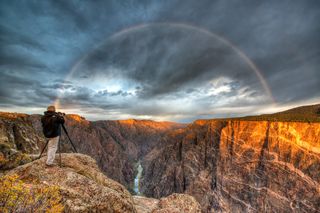
Black Canyon, of the Gunnison National Park, has some of the steepest cliffs, oldest rocks and craggiest spires in North America. It also has some of the most spectacular rainbows, as the above image shows.
Over two million years, the Gunnison River sculpted this amazing Colorado canyon, which contains some of the oldest exposed rock on Earth. The weathered canyon today is an outdoor adventurer's playground.
The inner canyon is home to grueling hikes where trekkers in peak condition can test themselves. The canyon is a hub for rock climbing, but most of the climbs are best left to advanced climbers. Rafting is also big here, and again, very difficult. The rafting run through the park is extremely technical and includes class V rapids, which are for experts only.
Humans are not the only things climbing high and moving fast in Black Canyon. The park is also home to Peregrine falcons, which can reach speeds of over 200 mph (322 kph) in an aerial dive, making them the fastest bird in the world
- Brett Israel, OurAmazingPlanet Contributor
Follow OurAmazingPlanet @OAPlanet, Facebook & Google+.
Delicate Dragonfly
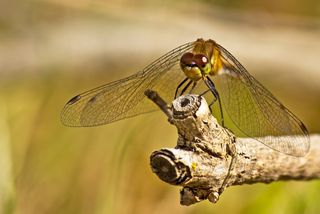
A meadowlark dragonfly shows off its delicate wings at Rachel Carson National Wildlife Refuge in Maine. Dragonflies are apparently experiencing a moment in the sun: According to the U.S. Fish & Wildlife Service, dragonfly festivals and dragonfly field guides are becoming increasingly popular. No surprise — with their jewel-like colors and gossamer wings, dragonflies give butterflies a run for their money in the beauty department. [See more surprisingly beautiful insects]
Swan Lake
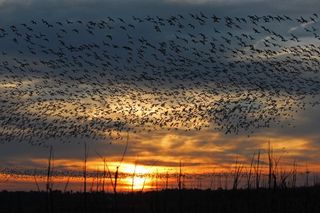
Can you guess the location of this gorgeous sunset scene?
This is Pocosin Lakes National Wildlife Refuge, approximately 110,000 acres of bird-friendly wetlands in eastern North Carolina. Ducks, raptors and black bears call the refuge home, as does the reintroduced endangered red wolf. Streaking across the sunset sky in this image are hundreds of tundra swans. These white birds migrate from their breeding grounds along the Arctic Ocean down the U.S. Atlantic coast in the winter, sometimes reaching as far south as Florida.
Space Station Sunrise
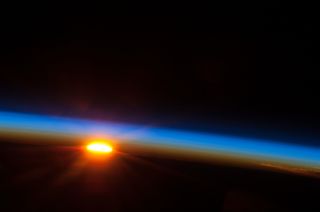
Sing along now: "It's just another ISS sunrise…" Okay, maybe the modified lyrics don't quite scan. Nevertheless, this image from the International Space Station captures the beauty of sunrise from space. This view is over the South Pacific, but astronauts aboard the ISS get plenty of chances to see the sun come up: Because of the speed of the vessel's orbit, they see a sunrise and sunset about every 45 minutes, or about 16 every 24 hours. This particular shot was taken on May 5, 2013.
Deadly Storms
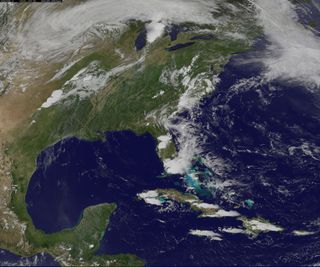
A line of deadly storms moves through Oklahoma in this image captured by NASA's MODIS satellite at 2:40 p.m. CDT on May 20, 2013. As this picture was taken, a deadly tornado, likely a F-4, was beginning its deadly journey through Moore, Okla., a suburb of Oklahoma City. Dozens were killed and entire neighborhoods devastated as the mile-wide funnel cloud touched down.
Humpback Whale Kenai Fjords
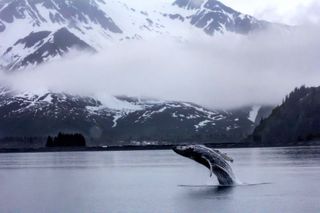
For an animal that can weigh more than two-dozen tons, humpback whales sure can catch some air.
As the above image shows, humpback whales often take flight in Alaska's Kenai Fjords National Park, at the edge of the North Pacific Ocean. The whales' enormous size makes for spectacular splashdowns. Male humpbacks grow to an average length of 46 feet (14 meters) and an average weight of 25 tons. Females are even bigger, at an average of 49 feet (14.9 m) long and 35 tons in weight.
Humpbacks are identified by their distinctive body shape and unusually long flippers, which are almost one-third of the whale's total body length. Humpback whales' dorsal fins are often a small triangular nubbin with a hump that is noticeable when a whale arches its back to dive. Humpback whales are often white or partially white. A white marking on the underside of the tail is like a marine mammal name tag in that each white marking is unique to each whale.
Humpback whales are an endangered species. Their worldwide population was estimated in 2007 at 30,000 to 40,000 whales. The North Pacific population found in Alaska is thought to be around 6,000 whales.
- Brett Israel, OurAmazingPlanet Contributor
Follow OurAmazingPlanet @OAPlanet, Facebook & Google+.
Awesome Otter
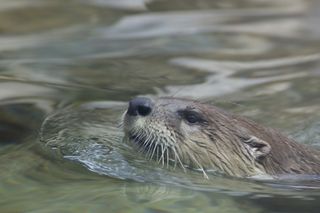
Ahanu the otter slips through the water at the Denver Zoo. The two-year-old male is a new zoo resident, brought from the Oakland Zoo in California to keep Denver's previous male otter, Otto, company. Otto's earlier companion Ariel died of old age last year, and given otters' highly social nature, Otto needed a new friend. For more otter adorableness, check out these pups getting a checkup
Sign up for the Live Science daily newsletter now
Get the world’s most fascinating discoveries delivered straight to your inbox.
Surprise Spacewalk

Astronaut Chris Cassidy is framed by Earth and space during an unplanned May 11, 2013 spacewalk to fix a coolant leak aboard the International Space Station. Along with Tom Marshburn, Cassidy spent five and a half hours outside the ISS fixing a pump control box. The ammonia leak wasn't a danger to the crew but would have decreased the amount of power available onboard. [Read More About the Surprise Spacewalk]
Peek-A-Boo!
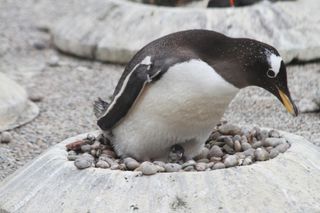
What's going on out there? At just a few hours old, this baby gentoo penguin peaks out from beneath its parent. The as-yet-nameless chick is the first gentoo born at Edinburgh Zoo this year. According to the zoo, a sibling joined this curious chick several hours later, and a third in the clutch was working its way out of the egg. [Happy Feet: A Gallery of Pudgy Penguins]
Striking Photo: Lightning Hits Grand Canyon
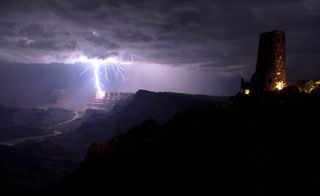
In one of the most amazing images you'll ever see, a photographer standing near the South Rim of the Grand Canyon captured lighting striking the famous landmark.
Carved by the Colorado River, the Grand Canyon is one of the most famous and flocked-to natural features in the world. The canyon is 277 miles (446 kilometers) long, up to 18 miles (29 km) wide and over a mile (1,800 meters) deep. Some 2 billion years of history are seen in the canyon's walls.
Lightning is common at the Grand Canyon, especially during late spring and summer thunderstorms, which bring needed rain to the Colorado River. From 1997 to 2000, lightning struck somewhere in Grand Canyon National Park 104,294 times, averaging 26,073 strikes per year, according to the National Park Service. The canyon's rims, rocky outcrops and other open areas are particularly vulnerable to lightning strikes. [7 Amazing Grand Canyon Facts]
About 600 deaths have happened in the Grand Canyon since the 1870s.
- Brett Israel, OurAmazingPlanet Contributor
Tadpole Eat ... Tadpole?
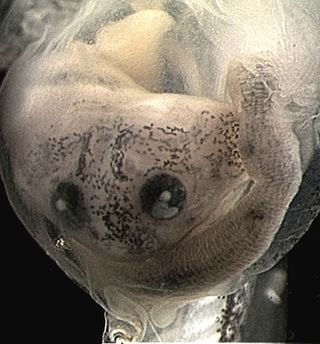
Most tadpoles survive on a diet of algae. But not Lepidobatrachus laevis, the tadpole of Budgett's frog. Not only are Budgett's frog tadpoles carnivorous, they're cannibals — as this image of a Budgett's frog tadpole slowly digesting in the gut of another Budgett's frog tadpole reveals.
North Carolina State developmental biologist Nanette Nascone-Yoder and her colleagues are using these carnivorous tadpoles to study how the digestive organs evolved and develop. In a study published in May 2013 in the journal Evolution and Development, Nascone-Yoder and her colleagues genetically engineered algae-eating tadpole guts to look more like that of the Budgett's tadpoles and vice versa.
"Understanding how and why the gut develops different shapes and lengths to adapt to different diets and environments during evolution gives us insight into what types of processes can be altered in the context of human birth defects, another scenario in which the gut also changes its shape and function," Nascone-Yoder said in a statement.











